ILC's Treatment for Facet Joint Syndrome (Intervertebral Arthritis / Arthritic Back Pain)
Having been adopted in over 54 countries globally,
the "Cellgel Method" for treating lower back pain
is now available in Japan
For those who have been told it was impossible to operate,
For those who have had recurrence of pain post-surgery,
A low-risk, outpatient treatment is now an option for you.
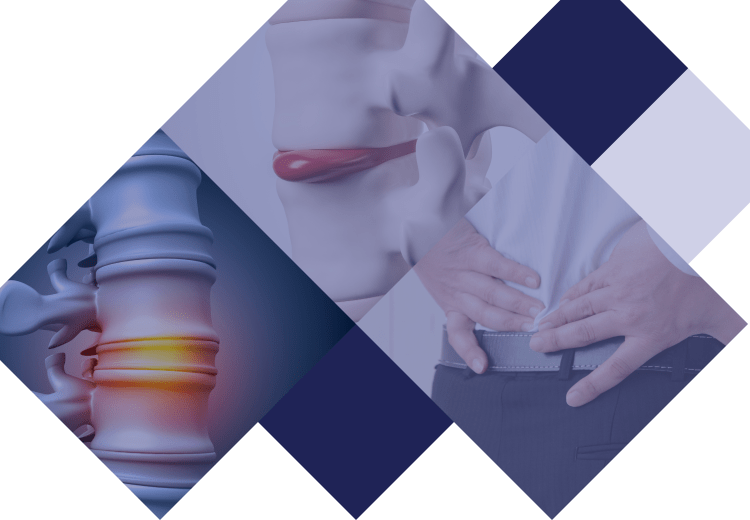
Contents
 Table of Contents
Table of Contents
This page provides information on the main symptoms and causes of facet joint syndrome and our treatment procedures. The information includes the method of treatment, treatment time, and information about insurance. We use the Cellgel method, which is one of the most advanced methods in the world, and the characteristics of this method are also described in detail.
Please read this page especially if you have been told that you cannot be cured without surgery, if you have had surgery in the past but have not improved, or if you got better after surgery but the symptoms have recurred.
What is facet joint syndrome?
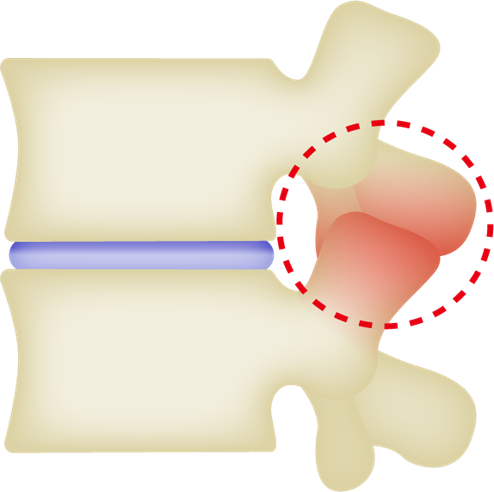
Facet joint syndrome is an arthritis-like condition that causes inflammation of the joints at the back of the spine. What is commonly called a 'strained back' is also an acute form of facet joint disease. Although it used to be disregarded in orthopedic books, it has recently become clear that it in fact accounts for a large part of the causes of lower back pain.
"According to a recently published report detailing the causes of low back pain by Japanese orthopedic specialists, the breakdown of causes of low back pain is 22% intervertebral joint and 18% myofascial..."
* Taken from the second edition of the revised Lumbago Medical Guidelines 2019 (Japanese): https://minds.jcqhc.or.jp/docs/gl_pdf/G0001110/4/Low_back_pain.pdf
Main symptoms of facet joint syndrome
The following are the main symptoms of facet joint syndrome:
- Pain when bending backward at the waist
- Pain when twisting at the waist (movements like swinging a baseball bat or golf club)
- Pain when getting up after bending over, being unable to become upright again
- Pain near the spine
- Pain when twisting the upper body to the left or right while arching the back
- Inability to remain in a seated position for long periods of time
- Taking a long time to get up after being seated for a time
- Pain just from walking
- Pain increases with exercise
Unlike in symptoms of disc herniation, numbness in the legs is here.
However, progression of facet joint syndrome / intervertebral arthritis can cause distortion of the spine, which in turn can compress the nerves, resulting in numbness in the legs.
If you have any of these symptoms, we recommend that have it checked as soon as possible.
Causes of facet joint syndrome
It is generally believed that aging, excessive pressure on the intervertebral joints, compression fractures of the spine, slippage, and instability due to surgery are linked to degeneration and inflammation of the facet joints, which results in pain.
In addition, recent studies have shown that intervertebral disc degeneration is one of the most important factors in facet joint syndrome.
(Reference: "A Systematic Review and Meta-Analysis of the Facet Joint Orientation and its effect on the Lumbar") https://www.ncbi.nlm.nih.gov/pmc/articles/PMC8888088/ome.
Our clinic also believes that disc degeneration causes instability of the intervertebral discs, which places continuous strain on the facet joints that support the back and are responsible for mobility, resulting in inflammation of the joints, which causes pain. Therefore, it is very important to treat the cause of the disc degeneration as well as the inflammation to get to the underlying cause of the pain.
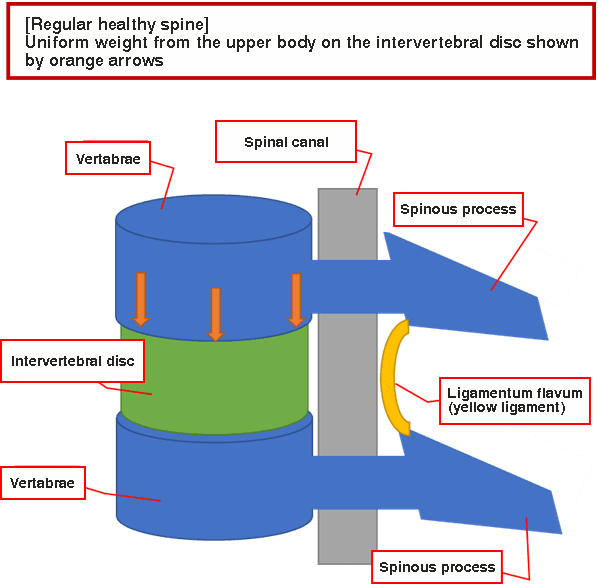
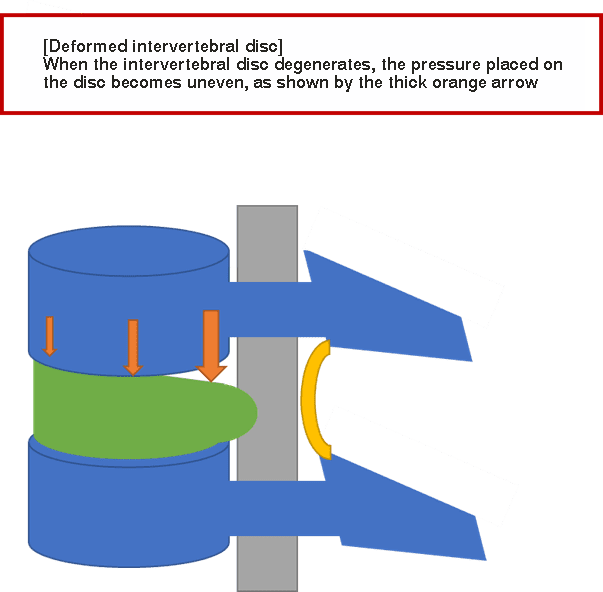
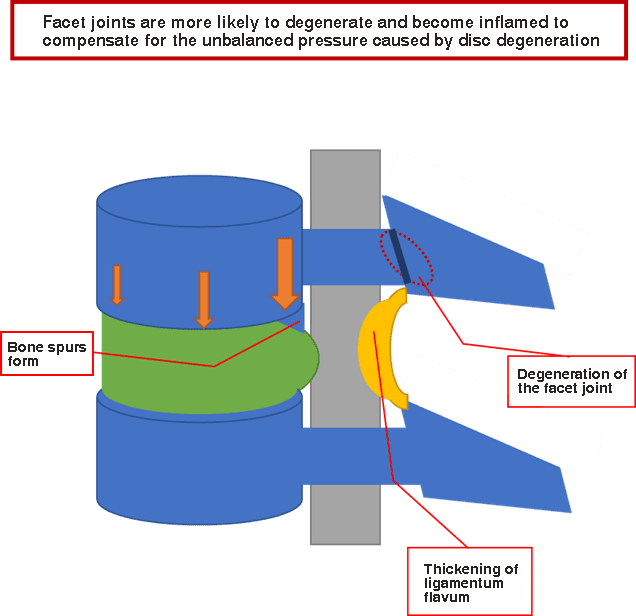
What are the effective treatments for facet joint syndrome?
In general, pain relief from inflammation of the joints is often achieved with blocking injections or steroid injections. While we believe that such treatments are effective to a certain extent, we have adopted a more advanced technology, the PODD method (Percutaneous Ozone Disc Decompression), to remove inflammation and reduce pain. Ozone has been used mainly in Europe, and its effect is believed to be to stimulate the body with ozone, thereby producing a strong immune response and ending the inflammation in a short time.
With facet joint syndrome, inflammation/arthritis and worsening of symptoms in the intervertebral joints often have their root cause in degeneration of intervertebral discs.
Therefore, our clinic believes that if the degeneration of the intervertebral disc can be controlled, inflammation and pain related to facet joint syndrome and intervertebral arthritis can be prevented.
As a treatment for this, disc repair treatment using the Cellgel method restores disc function by repairing the torn annulus fribrosus and replenishing the water content of the nucleus pulposus inside.
The treatment can be performed as a one-day procedure. Local anesthesia is given to the lower back, a needle is inserted into the disc, and a chemical solution is injected.
The treatment takes about 25 minutes and patients can go home after resting for about an hour.
Ozone Treatment
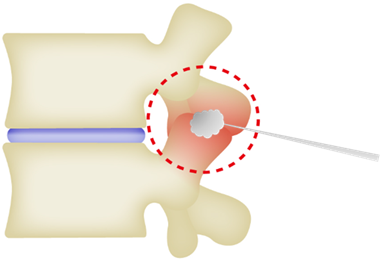
Ozone is injected through the tip of a needle inserted into the inflamed area of the joint.
The anti-inflammatory effect of ozone reduces the inflammation that causes pain.
Cellgel Method
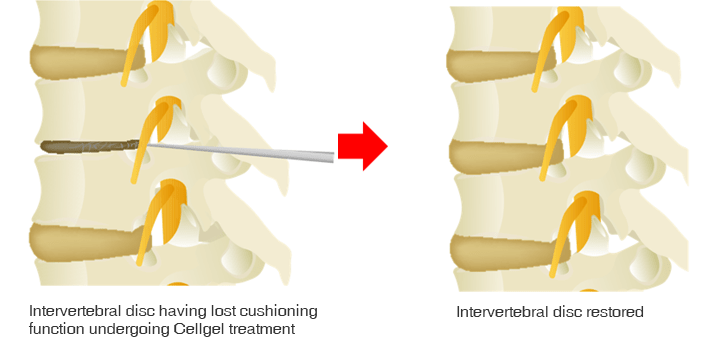
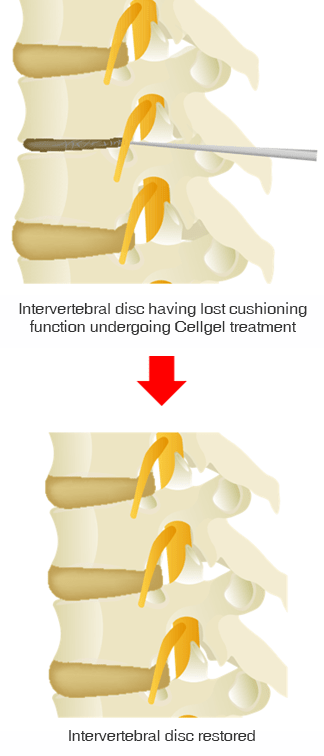
Since many of our patients come from far away,
we are happy to give free consultations to see which treatment is best for you
We'll diagnose your MRI images for free!
Treatment at ILC
There are four main treatments at our clinic.
As mentioned above, the root cause of each back pain disease is "inflammation and deformation due to aging of the intervertebral discs." Although the four treatment methods have different features and advantages, we would like to first introduce the "Cellgel method," which is the only one capable of intervertebral disc repair.
The Cellgel Method
About Cellgel
The Cellgel method is an advanced treatment for low back pain that has been implemented in more than 54 countries worldwide, predominantly in Europe.
As with other treatments, it does not decrease the disc volume, and since the drug remains in the disc as a gel-like implant after treatment, the disc can be preserved. Recent studies have also shown that the volume of the disc increases after treatment.*1
It is also thought that by repairing the disc and preventing leakage of the Nucleus Pulposus, the disc itself will restore its normal function with its own regenerative ability (*2).
It is particularly recommended for patients who are concerned about the risk of conventional disc surgery (MED, PELD, etc.).
*1 Source: European Journal of Radiology 109 (2018) 101–107 , Efficiency of an ethyl alcohol gel in symptomatic disc hernation
*2 Source: International Journal of Spine Surgery Vol. 15 Appendix 1 from regenerative treatment of disc degeneration
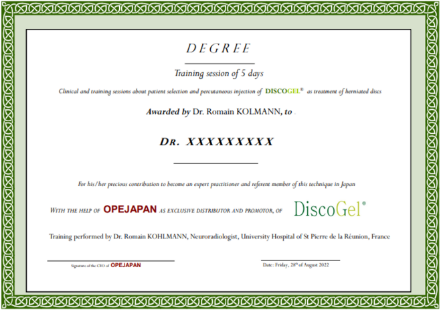
"Very good or good results were obtained in 202 (91.4%) of the 221 patients in group A. Of the 44 patients in group B, 37 patients (84%) presented very good or good results and in 9 (82%) of the 11 patients of group C, we obtained similar results. There was no allergic complication in any of our patients. Long-term follow-up magnetic resonance showed a dramatic reduction in hernia volume."
- Dr. J. Theron, one of the world's leading experts in the treatment of Celgel method, from his research article "Percutaneous Treatment of Lumbar Intervertebral Disk Hernias With Radiopaque Gelified Ethanol - A preliminary study."
Merits of Cellgel
- Possibility to repair intervertebral discs where unable to using surgical or laser treatment
- As the disc is repaired, the disc itself regains its original normal function through its own regenerative ability
- The Cellgel method uses local anesthesia over general anesthesia used in conventional surgery, making it less burdensome on the body
- Treatment is done with a thin needle, so the wound is minimal and recovery is rapid
- Treatment is very short, allowing for outpatient day treatment
- Safe, modern treatment proven in more than 54 countries around the world
Flow Cellgel Treatment Process
-
01 Examination

MRI and X-rays will be taken, followed by a doctor's diagnosis.
If the diagnosis proves the Cellgel method suitable, treatment can begin that same afternoon. -
02 Before

TreatmentAfter entering the treatment room and administering local anesthesia to the lower back, a needle is inserted into the intervertebral disc identified in the examination.
A contrast scan is performed to confirm the location of the damaged disc. -
03 Treatment
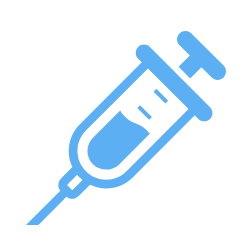
The Cellgel drug is administered to the damaged area while confirming the location of the disc with a fluoroscopy device.
Once the drug has been absorbed, the needle is removed and the bleeding is stopped.
-
04 Returning

HomeAfter the treatment, the patient rests in a private room for about an hour, and then allowed to go home after the post-treatment examination.
*Resting time depends on the patient's symptoms and condition.
Price Cost of Treatment for the Cellgel Method
| Number of Discs Treated |
1 disc | 2 discs | 3 discs | 4 discs | 5 discs |
|---|---|---|---|---|---|
| Treatment Cost | 1,320,000 JPY | 1,430,000 JPY | 1,540,000 JPY | 1,650,000 JPY | 1,760,000 JPY |
Swipe left/righ
* The cost of treatment is indicated including taxes.
*If treatment is performed at our clinic, all examination/diagnosis costs and test costs such as MRI are included in the above costs.
*This treatment method is not covered by Japanese health insurance, so you will have to pay for the entire treatment yourself.
*Payment by credit card (VISA, MasterCard, JCB, American Express, Diners, Discover) is also possible.
*If you would like rehabilitation (low back pain specialized rehabilitation), it is also possible to pay by bank transfer.
*If you live and work in Japan, you can receive a tax refund by filing your final medical expense return.
FAQ FAQ about facet joint syndrome and treatment
-
QWhat's the difference in the reccurence rate between Cellgel and conventional surgery?
-
A
Surgical procedures, which began in the 1960s, aimed to remove and sometimes fix deformed bones and herniated tissue. However, new bone damage caused by screws and the lack of fundamental treatment (repair of the intervertebral disc annulus fibrosus) resulted in the appearance of additional back pain and recurrence rates.
Therefore, in the 1980s, the need for fundamental treatment increased, and the intervertebral disc treatment (Cellgel) that we provide at our clinic began. Cellgel, in particular, have been proven to repair and regenerate the intervertebral disc, resulting in not only improvement of symptoms, but also an extremely low recurrence rate.
-
QHow is the disc to be treated determined?
-
AThe doctor will spend about 30 minutes with the patient while looking at the MRI and X-ray images to determine the cause of the condition, determine the treatment area, and explain the corresponding treatment method to the patient. MRI images show the main factors that contribute to back pain (disc, nerve, ligament, and joint), such as changes in shape, pressure on the nerve, presence or absence of damage, and inflammation. The x-ray image mainly confirms the condition of the bones.
-
QWhy is the Cellgel method applicable to cases where surgery showed no improvement?
-
ADuring surgery for disc herniation, the prolapsed herniation is removed, but the damaged disc remains intact. As a result, fresh nucleus pulposus components leak from the damaged disc and inflammation persists. On the other hand, our treatment can treat the disc injury itself, thus suppressing inflammation by reducing the fresh leakage of nucleus pulposus components.
-
QMy back pain may temporarily worsen after treatment. How long will it last?
-
AThe reason for the lower back pain is that spinal ligaments that have been compressed are stretched; the lower back pain lasts for about two weeks and then subsides.
-
QWhat level of exercise can I perform after treatment?
-
AGeneral recreational exercise and sports can be done without any problem. For professional athletes, the possibility of new disc damage is high and should be discussed in consultation with a doctor.
-
QPlease tell me about what I should be cautious about after treatment.
-
ADuring the first few days after treatment, the patient should rest and avoid prolonged sitting, heavy lifting, twisting, bending, or strenuous exercise. Patients should be able to perform routine tasks one week after treatment and should be able to perform light exercise by the second week. Weight training is allowed after 3 months.
-
QIs the treatment covered by the Japanese national health insurance?
-
ANo, it is not covered by the national insurance. If you have life insurance, you may be eligible. Please feel free to consult our staff regarding this matter.
-
QHow long must I wait to be able to walk after treatment?
-
AIt is an outpatient/day treatment, so you can walk about an hour after the surgery.
-
QHow many doctor visits do I need to make before treatment?
-
AWe require an MRI to be taken within three months for remote diagnosis, either with our affiliated clinic or from data sent by you. You can receive treatment on the same day after phyiscal diagnosis. You may also request only the diagnosis and come back only for the treatment at a later date.
-
QCan I fly immediately after the treatment?
-
AIf there are no problems after the treatment, you may fly. If there is any pain after the treatment, flying may not be recommended depending on the doctor's evaluation.
-
QWhat should I be cautious of when I am diagnosed with facet joint syndrome?
-
AOnce you have been diagnosed with facet joint syndrome, the first step is to prevent further disc and bone degeneration. If you perform a lot of back-straining activities or tasks, reduce the frequency of such movements, and listen carefully to your doctor's advice to determine what you should do next.
-
QWhat is the difference between facet joint syndrome and disc herniation?
-
A
Disc herniation is a case in which the nucleus pulposus in the disc protrudes outward and compresses the nerve, causing pain.
Facet joint syndrome refers to cases where pain is caused by degeneration of the disc, thickening of the ligaments, or the appearance of bone spurs. From facet joint syndrome, it may progress to disc herniation, spinal canal stenosis, and other conditions.
-
QCan facet joint syndrome be cured without surgery?
-
AUnfortunately, there is no complete cure for bone deformities.
It is possible to reduce inflammation and prevent the worsening of pain and progression of symptoms by relieving symptoms and improving the overall physical condition of the patient.
-
QAre there medications to cure facet joint syndrome?
-
A
Medication will not fundamentally cure the disease.
However, medications may be prescribed to relieve pain and improve blood flow. For severe pain, it may be necessary to take painkillers. Patients who have been taking medication for a long time may experience other pain and side effects if the medication is abruptly stopped.
-
QCan I continue working if I have facet joint syndrome?
-
A
It is possible to continue, depending on the severity of the symptoms.
However, if your job involves a lot of desk work or heavy labor, you need to refrain from such work as much as possible, as it is hard on the lower back.
If it is difficult to change your work environment, consider improving your physical condition, posture, and muscle strength. If these methods improve the condition, we recommend that you continue to use them.If there is no improvement, we recommend that you consult a doctor and receive a diagnosis.
-
QWhat does rehabilitation for facet joint syndrome involve?
-
AExercises and acupuncture are performed to improve the movement of the facet joints (joints in the spine) that are having difficulty moving, and to correct movements that are putting strain on the joints themselves.
-
QCan I still do rehabilitation if I have pain or numbness from my joints?
-
ARehabilitation can be done to alleviate symptoms such as pain and numbness.
Pain and numbness may appear when we move you to check the condition of your body, we will perform exercises that do not cause these symptoms.
-
QWill twisting my body during rehabilitation put any strain on my joints?
-
AIf the body can be twisted correctly, there is no burden.
If the hip joints, lower back, etc. are stiff and not twisted in the correct motion, the intervertebral joints will be burdened.
ILC Rehabilitation X Facet Joint Syndrome Treatment
Although the Cellgel method can repair and regenerate the disc itself, and other treatment methods we offer can fundamentally heal the disc; it is possible that the cause of back pain is not only the disc, but also muscles, joints, and ligaments that are affected by the disc.
In cooperation with our rehabilitation specialists, we recommend treating back pain caused by muscles, joints, and ligaments together.
We also offer a short-term intensive program for patients who live far away or overseas.
-
ILC's Low Back Pain Treatment
Outpatient Treatment
Improve back pain disorders/
symptoms in relation to the nerves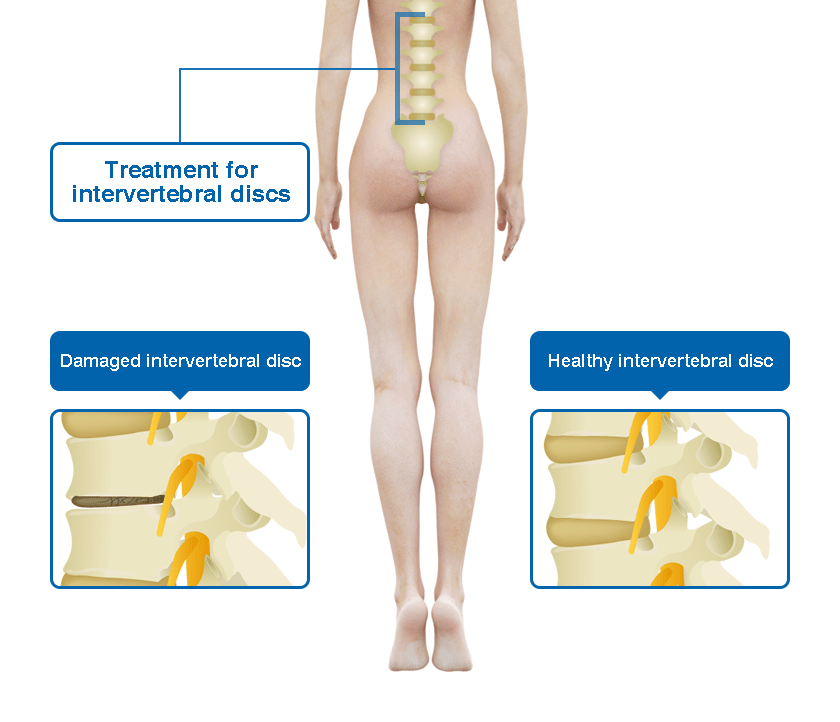
-
ILC's Rehabilitation Program
Specialized Low Back Pain Rehabilitation
Improve back pain disorders/symptoms in
relation to the joints, muscles, ligaments
-
01
ILC's Specialized Back Pain Rehabilitation
Our Rehabilitation Approach to Facet Joint Symdrome
At our rehabilitation center, we believe that understanding the cause of facet joint pain is the most important thing, and we work based on the following concepts:
- Factors that contribute to facet joint syndrome are not only the joints themselves, but also the body as a whole.
↓ - Individuals' daily life and lifestyle habits add to "the entire body" being the cause
↓ -
Examples of daily life and lifestyle habits that cause intervertebral arthritis and facet joint pain
- Warped / slouched back
- Prolonged stooping posture
- Prolonged standing
- Reduced flexibility of glute muscles
- Factors that contribute to facet joint syndrome are not only the joints themselves, but also the body as a whole.
-
02
ILC's Specialized Back Pain Rehabilitation
How to Evaluate Facet Joint Symdrome
The following three methods of evaluation are used in our rehabilitation program.
- 1. Since the cause of the problem is caused by the accumulation of daily habits, we will carefully and thoroughly listen to the patient's daily life and evaluate the patient's condition.
- 2. We will search for the cause of the pain more precisely by actually moving the body and reproducing the pain under the guidance of our professional staff.
- 3. We use a spinal mouse to visualize and evaluate the alignment of the spine in more detail.

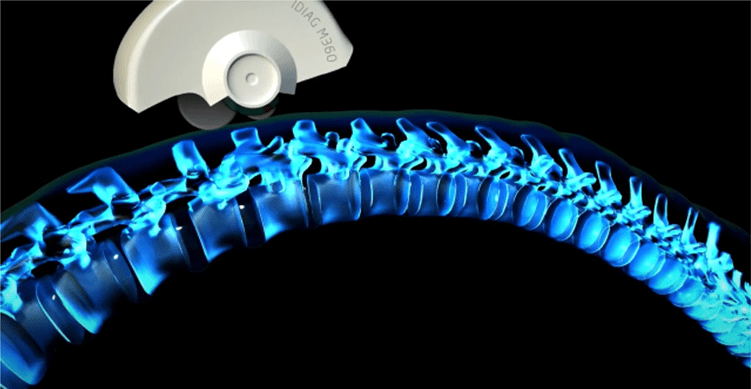
Image: Evaluation with a spinal mouse
-
03
ILC's Specialized Back Pain Rehabilitation
Rehabilitation Treatment for Facet Joint Symdrome
[Premise]
While bending and twisting of the lower back are often the cause of the discomfort, the main goal of treatment is to find the way of movement and posture that causes pain and correct it during the actual rehabilitation process. The following are two specific examples:- 1. Postures in which only the hips are rotated (without using shoulder and chest rotation) to pick up objects or working with the hips twisted
- 2. Working with poor posture due to a lack of inner muscles and antigravity muscles, which are the muscles that support the body.
These daily body movements and postures are difficult to notice by ourselves.
However, they are the cause of inflammation of the intervertebral joints, and are greatly related to the exacerbation of inflammation.[Treatment]
Generally, in the early postoperative period, the patient moves his/her body in a pain-free direction to the extent that there is no pain.Focusing on exercises that can be done lying down, which are less stressful on the lower back, we will improve weakened muscle strength and enable the use of muscles that have become stiff and difficult to use.
By having the patients practice exercises that are easy to perform daily, rather than with weights, the burden on the joints will be reduced by modifying the way they move their bodies and their posture, which will lead to pain relief.
-
04
ILC's Specialized Back Pain Rehabilitation
Treatment Period for Facet Joint Syndrome
Inflammation of the facet joint syndrome itself tends to be alleviated in about one to two weeks, depending on the individual, if the Cellgel method is used and rehabilitation is performed.
However, in the long term, pain may recur due to various factors, so exercise under the guidance of rehabilitation staff is essential to maintain a good treatment prognosis.
We aim to achieve 100% effectiveness of treatment while incorporating the latest technology, so we spend at least 30 minutes with each patient to carefully and meticulously examine the patient's concerns in order to make a proper diagnosis and propose the most suitable treatment methods.
We are certain to find a way to alleviate or eliminate the pain and numbness you are experiencing, so please do not give up and give us a call instead!
- Tadaaki Minowa, Clinic Director



